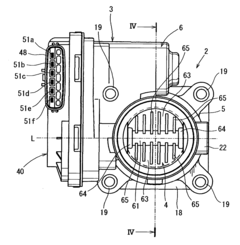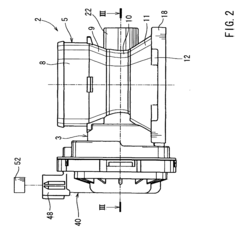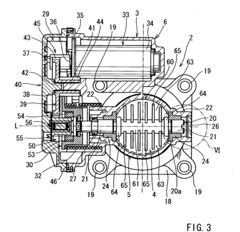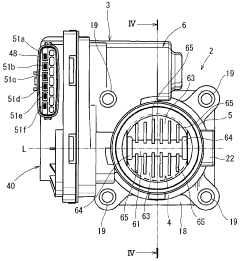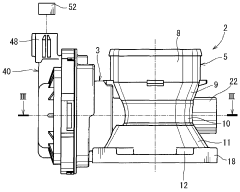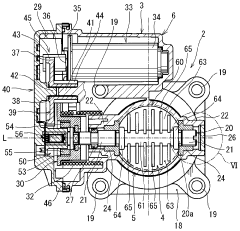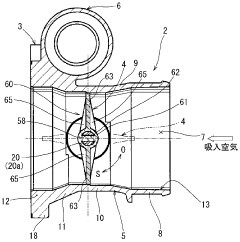Throttle Body Applications in Advanced Manufacturing Systems
JUL 18, 20259 MIN READ
Generate Your Research Report Instantly with AI Agent
Patsnap Eureka helps you evaluate technical feasibility & market potential.
Throttle Body Evolution
The throttle body has undergone significant evolution since its inception, transitioning from a purely mechanical device to a sophisticated electronic component in advanced manufacturing systems. Initially, throttle bodies were simple butterfly valves controlled by a cable connected to the accelerator pedal. This mechanical system, while effective, lacked precision and responsiveness.
The first major advancement came with the introduction of electronic throttle control (ETC) in the 1980s. This system, also known as drive-by-wire, replaced the mechanical linkage with electronic sensors and actuators. ETC allowed for more precise control of the engine's air intake, improving fuel efficiency and reducing emissions. It also enabled the integration of advanced features such as cruise control and traction control systems.
As manufacturing systems became more advanced, the throttle body evolved to incorporate more sensors and intelligent control mechanisms. Modern throttle bodies often include position sensors, airflow sensors, and temperature sensors, all working in concert to provide real-time data to the engine control unit (ECU). This data-driven approach allows for dynamic adjustments to engine performance based on various factors such as load, temperature, and driving conditions.
In recent years, the focus has shifted towards miniaturization and integration. Throttle bodies are now being designed as part of larger intake modules, combining multiple functions into a single unit. This integration not only reduces the overall size and weight of the engine system but also improves reliability by reducing the number of separate components and connections.
The materials used in throttle body construction have also evolved. Traditional materials like brass and aluminum are being supplemented or replaced by high-performance plastics and composite materials. These new materials offer benefits such as reduced weight, improved thermal management, and enhanced durability in harsh engine environments.
Another significant development is the incorporation of adaptive learning algorithms into throttle body control systems. These algorithms allow the throttle body to adjust its operation over time, compensating for wear and changes in engine performance. This self-calibrating capability ensures optimal performance throughout the life of the vehicle and reduces the need for manual adjustments during maintenance.
Looking towards the future, the evolution of throttle bodies is likely to continue in the direction of increased electrification and integration with hybrid and electric vehicle systems. As internal combustion engines become more efficient and emissions regulations become stricter, throttle bodies will play a crucial role in precise air management for optimal combustion and emissions control.
The first major advancement came with the introduction of electronic throttle control (ETC) in the 1980s. This system, also known as drive-by-wire, replaced the mechanical linkage with electronic sensors and actuators. ETC allowed for more precise control of the engine's air intake, improving fuel efficiency and reducing emissions. It also enabled the integration of advanced features such as cruise control and traction control systems.
As manufacturing systems became more advanced, the throttle body evolved to incorporate more sensors and intelligent control mechanisms. Modern throttle bodies often include position sensors, airflow sensors, and temperature sensors, all working in concert to provide real-time data to the engine control unit (ECU). This data-driven approach allows for dynamic adjustments to engine performance based on various factors such as load, temperature, and driving conditions.
In recent years, the focus has shifted towards miniaturization and integration. Throttle bodies are now being designed as part of larger intake modules, combining multiple functions into a single unit. This integration not only reduces the overall size and weight of the engine system but also improves reliability by reducing the number of separate components and connections.
The materials used in throttle body construction have also evolved. Traditional materials like brass and aluminum are being supplemented or replaced by high-performance plastics and composite materials. These new materials offer benefits such as reduced weight, improved thermal management, and enhanced durability in harsh engine environments.
Another significant development is the incorporation of adaptive learning algorithms into throttle body control systems. These algorithms allow the throttle body to adjust its operation over time, compensating for wear and changes in engine performance. This self-calibrating capability ensures optimal performance throughout the life of the vehicle and reduces the need for manual adjustments during maintenance.
Looking towards the future, the evolution of throttle bodies is likely to continue in the direction of increased electrification and integration with hybrid and electric vehicle systems. As internal combustion engines become more efficient and emissions regulations become stricter, throttle bodies will play a crucial role in precise air management for optimal combustion and emissions control.
Market Demand Analysis
The market demand for throttle body applications in advanced manufacturing systems has been experiencing significant growth in recent years. This surge is primarily driven by the increasing adoption of automation and precision control in various industrial processes. The automotive industry remains a key driver, with stringent emission regulations and the push for fuel efficiency propelling the demand for advanced throttle body systems.
In the automotive sector, the global market for electronic throttle bodies is projected to expand at a compound annual growth rate (CAGR) of over 5% through 2025. This growth is attributed to the rising production of vehicles equipped with electronic fuel injection systems and the increasing integration of throttle bodies with engine management systems for improved performance and fuel economy.
Beyond automotive applications, the demand for throttle bodies in advanced manufacturing systems is expanding into diverse industries. Aerospace and defense sectors are increasingly incorporating throttle body technology in aircraft engines and unmanned aerial vehicles (UAVs) for precise control of air intake and fuel mixture. The marine industry is also adopting advanced throttle body systems for better engine performance and fuel efficiency in commercial and recreational vessels.
The industrial automation sector presents a growing market for throttle body applications, particularly in process control and robotics. Throttle bodies are being utilized in pneumatic systems for precise air flow control in manufacturing processes, enhancing overall system efficiency and product quality. The food and beverage industry is another emerging market, where throttle bodies are employed in packaging and processing equipment for accurate control of gas and liquid flows.
Market trends indicate a shift towards smart throttle body systems integrated with IoT and AI technologies. These advanced systems offer real-time monitoring, predictive maintenance, and adaptive control capabilities, aligning with the Industry 4.0 paradigm. This trend is expected to drive further market growth and innovation in throttle body applications across various manufacturing sectors.
The Asia-Pacific region is anticipated to witness the highest growth rate in the throttle body market, fueled by rapid industrialization, increasing automotive production, and government initiatives promoting advanced manufacturing technologies. North America and Europe continue to be significant markets, driven by technological advancements and the presence of major automotive and aerospace manufacturers.
As environmental regulations become more stringent globally, there is a growing demand for throttle body systems that can enhance engine efficiency and reduce emissions. This trend is expected to drive research and development efforts towards more advanced and environmentally friendly throttle body technologies in the coming years.
In the automotive sector, the global market for electronic throttle bodies is projected to expand at a compound annual growth rate (CAGR) of over 5% through 2025. This growth is attributed to the rising production of vehicles equipped with electronic fuel injection systems and the increasing integration of throttle bodies with engine management systems for improved performance and fuel economy.
Beyond automotive applications, the demand for throttle bodies in advanced manufacturing systems is expanding into diverse industries. Aerospace and defense sectors are increasingly incorporating throttle body technology in aircraft engines and unmanned aerial vehicles (UAVs) for precise control of air intake and fuel mixture. The marine industry is also adopting advanced throttle body systems for better engine performance and fuel efficiency in commercial and recreational vessels.
The industrial automation sector presents a growing market for throttle body applications, particularly in process control and robotics. Throttle bodies are being utilized in pneumatic systems for precise air flow control in manufacturing processes, enhancing overall system efficiency and product quality. The food and beverage industry is another emerging market, where throttle bodies are employed in packaging and processing equipment for accurate control of gas and liquid flows.
Market trends indicate a shift towards smart throttle body systems integrated with IoT and AI technologies. These advanced systems offer real-time monitoring, predictive maintenance, and adaptive control capabilities, aligning with the Industry 4.0 paradigm. This trend is expected to drive further market growth and innovation in throttle body applications across various manufacturing sectors.
The Asia-Pacific region is anticipated to witness the highest growth rate in the throttle body market, fueled by rapid industrialization, increasing automotive production, and government initiatives promoting advanced manufacturing technologies. North America and Europe continue to be significant markets, driven by technological advancements and the presence of major automotive and aerospace manufacturers.
As environmental regulations become more stringent globally, there is a growing demand for throttle body systems that can enhance engine efficiency and reduce emissions. This trend is expected to drive research and development efforts towards more advanced and environmentally friendly throttle body technologies in the coming years.
Technical Challenges
The implementation of throttle body applications in advanced manufacturing systems faces several significant technical challenges. One of the primary obstacles is achieving precise control over airflow in complex industrial processes. Traditional throttle bodies often struggle to maintain accuracy and responsiveness in high-speed manufacturing environments, leading to inefficiencies and quality control issues.
Another major challenge lies in the integration of throttle bodies with advanced sensor systems and control algorithms. As manufacturing processes become increasingly automated and data-driven, there is a growing need for throttle bodies that can seamlessly interface with sophisticated control systems. This requires the development of advanced electronic control units (ECUs) capable of processing real-time data and making split-second adjustments to airflow.
Material selection and durability present additional hurdles in throttle body applications for advanced manufacturing. The harsh operating conditions in industrial settings, including exposure to extreme temperatures, corrosive substances, and high-pressure environments, demand materials that can withstand these challenges while maintaining precision and reliability over extended periods.
Miniaturization and space optimization pose significant technical difficulties, particularly in compact manufacturing systems where every millimeter counts. Engineers must develop innovative designs that reduce the footprint of throttle bodies without compromising their performance or functionality. This challenge is further compounded by the need to incorporate additional features such as integrated sensors and actuators within the same confined space.
Energy efficiency and sustainability considerations add another layer of complexity to throttle body applications in advanced manufacturing. As industries strive to reduce their carbon footprint and operational costs, there is increasing pressure to develop throttle bodies that minimize energy consumption while maximizing output. This requires a delicate balance between performance optimization and energy conservation.
Scalability and adaptability represent ongoing challenges in the implementation of throttle body technologies across diverse manufacturing processes. Developing solutions that can be easily scaled up or down to accommodate different production volumes and adapted to various industrial applications without significant redesign or retooling is a complex engineering task.
Lastly, ensuring the reliability and longevity of throttle body systems in continuous operation scenarios is crucial. Advanced manufacturing systems often run 24/7, leaving little room for downtime or maintenance. Developing throttle bodies that can maintain consistent performance over extended periods without frequent servicing or replacement is a significant technical challenge that requires innovative approaches to design, materials science, and predictive maintenance technologies.
Another major challenge lies in the integration of throttle bodies with advanced sensor systems and control algorithms. As manufacturing processes become increasingly automated and data-driven, there is a growing need for throttle bodies that can seamlessly interface with sophisticated control systems. This requires the development of advanced electronic control units (ECUs) capable of processing real-time data and making split-second adjustments to airflow.
Material selection and durability present additional hurdles in throttle body applications for advanced manufacturing. The harsh operating conditions in industrial settings, including exposure to extreme temperatures, corrosive substances, and high-pressure environments, demand materials that can withstand these challenges while maintaining precision and reliability over extended periods.
Miniaturization and space optimization pose significant technical difficulties, particularly in compact manufacturing systems where every millimeter counts. Engineers must develop innovative designs that reduce the footprint of throttle bodies without compromising their performance or functionality. This challenge is further compounded by the need to incorporate additional features such as integrated sensors and actuators within the same confined space.
Energy efficiency and sustainability considerations add another layer of complexity to throttle body applications in advanced manufacturing. As industries strive to reduce their carbon footprint and operational costs, there is increasing pressure to develop throttle bodies that minimize energy consumption while maximizing output. This requires a delicate balance between performance optimization and energy conservation.
Scalability and adaptability represent ongoing challenges in the implementation of throttle body technologies across diverse manufacturing processes. Developing solutions that can be easily scaled up or down to accommodate different production volumes and adapted to various industrial applications without significant redesign or retooling is a complex engineering task.
Lastly, ensuring the reliability and longevity of throttle body systems in continuous operation scenarios is crucial. Advanced manufacturing systems often run 24/7, leaving little room for downtime or maintenance. Developing throttle bodies that can maintain consistent performance over extended periods without frequent servicing or replacement is a significant technical challenge that requires innovative approaches to design, materials science, and predictive maintenance technologies.
Current Solutions
01 Throttle body design and structure
Throttle bodies are designed with specific structures to control airflow into an engine. They may include features like adjustable valves, airflow passages, and integrated sensors to optimize engine performance and fuel efficiency.- Throttle body design and construction: Throttle bodies are designed to control airflow into an engine's intake manifold. They typically consist of a housing with a butterfly valve that can be opened or closed to regulate air intake. Various designs focus on improving airflow efficiency, reducing turbulence, and enhancing overall engine performance.
- Electronic throttle control systems: Modern throttle bodies often incorporate electronic control systems, replacing mechanical linkages with sensors and actuators. These systems provide more precise control over engine performance, improved fuel efficiency, and integration with other vehicle systems such as traction control and cruise control.
- Throttle body cleaning and maintenance: Throttle bodies can accumulate carbon deposits and other contaminants over time, affecting their performance. Various cleaning methods and maintenance procedures have been developed to ensure optimal throttle body function, including specialized cleaning solutions and tools designed for this purpose.
- Throttle body integration with fuel injection systems: Many throttle body designs are integrated with fuel injection systems to optimize air-fuel mixture and engine performance. These integrated systems can include features such as built-in fuel injectors, air temperature sensors, and pressure regulators to enhance overall engine efficiency and power output.
- Throttle body modifications for performance enhancement: Aftermarket modifications and custom throttle body designs are used to increase engine performance in high-performance and racing applications. These modifications may include larger throttle bores, improved airflow characteristics, and integration with advanced engine management systems to maximize power output and throttle response.
02 Electronic throttle control systems
Modern throttle bodies often incorporate electronic control systems, including sensors and actuators, to precisely regulate airflow based on various engine parameters and driver input. These systems can improve responsiveness and fuel economy.Expand Specific Solutions03 Throttle body cleaning and maintenance
Throttle bodies require regular cleaning and maintenance to ensure optimal performance. Various methods and devices have been developed to clean throttle bodies without disassembly, removing carbon deposits and other contaminants that can affect airflow.Expand Specific Solutions04 Throttle body integration with intake systems
Throttle bodies are often integrated with other components of the engine intake system, such as air filters, mass airflow sensors, and intake manifolds. This integration can improve overall engine efficiency and reduce complexity.Expand Specific Solutions05 Throttle body modifications for performance
Aftermarket modifications to throttle bodies, such as enlarging the bore or altering the valve design, can increase airflow and potentially improve engine performance. These modifications are often used in high-performance and racing applications.Expand Specific Solutions
Key Industry Players
The throttle body market in advanced manufacturing systems is in a growth phase, driven by increasing demand for fuel-efficient vehicles and stringent emission regulations. The global market size is projected to expand significantly in the coming years, with key players like Bosch, Continental, and DENSO leading the way. These companies, along with others such as Aisan Industry and Mikuni, are investing heavily in R&D to improve throttle body technology. The technology is relatively mature but continues to evolve, with advancements in electronic throttle control systems and integration with other powertrain components. Emerging players like Vitesco Technologies and Zhejiang Geely are also making strides in this space, particularly in the context of electric and hybrid vehicle applications.
GM Global Technology Operations LLC
Technical Solution: GM Global Technology Operations has developed innovative throttle body applications for advanced manufacturing systems, focusing on integration with electric and hybrid powertrains. Their throttle bodies feature adaptive learning algorithms that optimize performance based on driving conditions and manufacturing process variables[7]. GM has implemented additive manufacturing techniques for producing complex throttle body geometries, allowing for improved airflow characteristics and reduced production time. The company has also developed a virtual testing environment for throttle bodies, enabling rapid prototyping and validation in simulated manufacturing conditions[8]. GM's throttle bodies incorporate advanced coating technologies to improve durability and reduce friction, leading to increased efficiency in both automotive and manufacturing applications.
Strengths: Integration with electric and hybrid systems, advanced manufacturing techniques, and virtual testing capabilities. Weaknesses: Potential complexity in implementation across diverse manufacturing environments, and possible higher initial costs for smaller manufacturers.
DENSO Corp.
Technical Solution: DENSO Corp. has innovated in throttle body applications for advanced manufacturing systems by developing a highly responsive electronic throttle control system. Their design incorporates a brushless DC motor for precise control and reduced wear[2]. DENSO's throttle bodies feature an integrated airflow sensor, allowing for more accurate air intake measurement and improved engine performance. The company has also implemented advanced manufacturing techniques, such as 3D printing for prototyping and small-batch production of custom throttle body components[4]. DENSO's throttle bodies are designed with a focus on weight reduction and compact size, making them suitable for a wide range of vehicle types and manufacturing environments.
Strengths: High precision control, integrated sensors for improved performance, and adaptability to various manufacturing setups. Weaknesses: Potential higher cost due to advanced features, and possible compatibility issues with older manufacturing systems.
Core Innovations
Throttle body and method of manufacturing the same
PatentInactiveUS20090159043A1
Innovation
- The throttle body design features end faces of the valve part and bearing members with improved sliding properties, where the bearing members' radii match or exceed the valve part's rotational radius, and the use of slide layers or materials with good sliding properties to reduce friction and prevent contact with the bore wall, thereby enhancing the operation and reducing wear.
Throttle body and method of manufacturing the same
PatentWO2005116420A1
Innovation
- A throttle body design featuring a valve portion with an end face that slides against a bearing member with a radius equal to or larger than the locus of rotation, and optionally incorporating materials or coatings with good lubricity, to reduce frictional resistance and prevent contact with the bore wall, along with integral molding of components to minimize costs and weight.
Manufacturing Impact
The integration of throttle body technology in advanced manufacturing systems has significantly transformed production processes across various industries. This impact is particularly evident in the automotive sector, where precision control of air intake has become crucial for optimizing engine performance and meeting stringent emissions standards.
In manufacturing environments, throttle bodies play a pivotal role in enhancing the efficiency and accuracy of production lines. By precisely regulating the flow of materials or components, these systems contribute to improved quality control and reduced waste. This level of control is especially valuable in industries such as food processing, pharmaceuticals, and chemical manufacturing, where precise ingredient measurements are critical.
The implementation of throttle body technology has led to notable improvements in energy efficiency within manufacturing facilities. By optimizing the flow of resources, including air, fuel, and raw materials, manufacturers can significantly reduce energy consumption and operational costs. This not only contributes to more sustainable manufacturing practices but also aligns with global initiatives for reducing industrial carbon footprints.
Advanced manufacturing systems incorporating throttle body technology have demonstrated enhanced flexibility and adaptability. The ability to quickly adjust production parameters through electronic throttle control systems allows manufacturers to respond more effectively to changing market demands and product specifications. This agility is particularly beneficial in industries with rapidly evolving consumer preferences or stringent regulatory requirements.
The impact of throttle body applications extends to the realm of predictive maintenance and Industry 4.0 initiatives. By integrating sensors and data analytics with throttle body systems, manufacturers can monitor performance in real-time, predict potential failures, and schedule maintenance proactively. This approach minimizes downtime, extends equipment lifespan, and optimizes overall production efficiency.
Furthermore, the adoption of throttle body technology in manufacturing has catalyzed innovation in related fields, such as robotics and automation. The precise control offered by these systems has enabled the development of more sophisticated robotic applications, enhancing the capabilities of automated production lines and contributing to the ongoing evolution of smart factories.
In conclusion, the integration of throttle body applications in advanced manufacturing systems has had a profound and multifaceted impact on industrial processes. From improving energy efficiency and product quality to enabling greater flexibility and predictive maintenance capabilities, this technology continues to drive innovation and efficiency across the manufacturing sector.
In manufacturing environments, throttle bodies play a pivotal role in enhancing the efficiency and accuracy of production lines. By precisely regulating the flow of materials or components, these systems contribute to improved quality control and reduced waste. This level of control is especially valuable in industries such as food processing, pharmaceuticals, and chemical manufacturing, where precise ingredient measurements are critical.
The implementation of throttle body technology has led to notable improvements in energy efficiency within manufacturing facilities. By optimizing the flow of resources, including air, fuel, and raw materials, manufacturers can significantly reduce energy consumption and operational costs. This not only contributes to more sustainable manufacturing practices but also aligns with global initiatives for reducing industrial carbon footprints.
Advanced manufacturing systems incorporating throttle body technology have demonstrated enhanced flexibility and adaptability. The ability to quickly adjust production parameters through electronic throttle control systems allows manufacturers to respond more effectively to changing market demands and product specifications. This agility is particularly beneficial in industries with rapidly evolving consumer preferences or stringent regulatory requirements.
The impact of throttle body applications extends to the realm of predictive maintenance and Industry 4.0 initiatives. By integrating sensors and data analytics with throttle body systems, manufacturers can monitor performance in real-time, predict potential failures, and schedule maintenance proactively. This approach minimizes downtime, extends equipment lifespan, and optimizes overall production efficiency.
Furthermore, the adoption of throttle body technology in manufacturing has catalyzed innovation in related fields, such as robotics and automation. The precise control offered by these systems has enabled the development of more sophisticated robotic applications, enhancing the capabilities of automated production lines and contributing to the ongoing evolution of smart factories.
In conclusion, the integration of throttle body applications in advanced manufacturing systems has had a profound and multifaceted impact on industrial processes. From improving energy efficiency and product quality to enabling greater flexibility and predictive maintenance capabilities, this technology continues to drive innovation and efficiency across the manufacturing sector.
Regulatory Compliance
Regulatory compliance plays a crucial role in the implementation of throttle body applications within advanced manufacturing systems. As these systems become increasingly sophisticated and integrated into various industries, adherence to regulatory standards ensures safety, reliability, and environmental responsibility.
In the automotive sector, throttle body applications must comply with stringent emissions regulations set by governing bodies such as the Environmental Protection Agency (EPA) in the United States and the European Union's Euro emissions standards. These regulations mandate specific performance criteria for throttle bodies to minimize harmful exhaust emissions and optimize fuel efficiency.
Manufacturing facilities utilizing throttle body applications in their production processes must adhere to workplace safety regulations. This includes compliance with Occupational Safety and Health Administration (OSHA) standards in the United States, which outline requirements for equipment safety, worker protection, and hazard mitigation.
The integration of throttle bodies in advanced manufacturing systems also necessitates compliance with industry-specific standards. For instance, in the aerospace industry, throttle body applications must meet the rigorous requirements set by organizations like the Federal Aviation Administration (FAA) and the European Union Aviation Safety Agency (EASA).
As advanced manufacturing systems increasingly incorporate IoT and connected technologies, data privacy and cybersecurity regulations become paramount. Throttle body applications that collect and transmit data must comply with regulations such as the General Data Protection Regulation (GDPR) in the European Union and the California Consumer Privacy Act (CCPA) in the United States.
Environmental regulations also impact throttle body applications in manufacturing. Many countries have implemented regulations to reduce industrial emissions and promote energy efficiency. Manufacturers must ensure that their throttle body systems align with these environmental standards, such as those outlined in the Paris Agreement and national climate action plans.
Compliance with electromagnetic compatibility (EMC) regulations is essential for throttle body applications in advanced manufacturing systems. These regulations, such as the EU's EMC Directive, ensure that electronic equipment does not interfere with other devices or systems, maintaining the integrity of manufacturing processes.
To maintain regulatory compliance, manufacturers must implement robust quality management systems and conduct regular audits. Certification to international standards such as ISO 9001 for quality management and ISO 14001 for environmental management can demonstrate commitment to regulatory compliance and continuous improvement.
As regulations evolve to address emerging technologies and environmental concerns, manufacturers must stay informed and adaptable. This may involve investing in research and development to create innovative throttle body solutions that meet or exceed regulatory requirements, ensuring long-term compliance and competitiveness in the global market.
In the automotive sector, throttle body applications must comply with stringent emissions regulations set by governing bodies such as the Environmental Protection Agency (EPA) in the United States and the European Union's Euro emissions standards. These regulations mandate specific performance criteria for throttle bodies to minimize harmful exhaust emissions and optimize fuel efficiency.
Manufacturing facilities utilizing throttle body applications in their production processes must adhere to workplace safety regulations. This includes compliance with Occupational Safety and Health Administration (OSHA) standards in the United States, which outline requirements for equipment safety, worker protection, and hazard mitigation.
The integration of throttle bodies in advanced manufacturing systems also necessitates compliance with industry-specific standards. For instance, in the aerospace industry, throttle body applications must meet the rigorous requirements set by organizations like the Federal Aviation Administration (FAA) and the European Union Aviation Safety Agency (EASA).
As advanced manufacturing systems increasingly incorporate IoT and connected technologies, data privacy and cybersecurity regulations become paramount. Throttle body applications that collect and transmit data must comply with regulations such as the General Data Protection Regulation (GDPR) in the European Union and the California Consumer Privacy Act (CCPA) in the United States.
Environmental regulations also impact throttle body applications in manufacturing. Many countries have implemented regulations to reduce industrial emissions and promote energy efficiency. Manufacturers must ensure that their throttle body systems align with these environmental standards, such as those outlined in the Paris Agreement and national climate action plans.
Compliance with electromagnetic compatibility (EMC) regulations is essential for throttle body applications in advanced manufacturing systems. These regulations, such as the EU's EMC Directive, ensure that electronic equipment does not interfere with other devices or systems, maintaining the integrity of manufacturing processes.
To maintain regulatory compliance, manufacturers must implement robust quality management systems and conduct regular audits. Certification to international standards such as ISO 9001 for quality management and ISO 14001 for environmental management can demonstrate commitment to regulatory compliance and continuous improvement.
As regulations evolve to address emerging technologies and environmental concerns, manufacturers must stay informed and adaptable. This may involve investing in research and development to create innovative throttle body solutions that meet or exceed regulatory requirements, ensuring long-term compliance and competitiveness in the global market.
Unlock deeper insights with Patsnap Eureka Quick Research — get a full tech report to explore trends and direct your research. Try now!
Generate Your Research Report Instantly with AI Agent
Supercharge your innovation with Patsnap Eureka AI Agent Platform!
